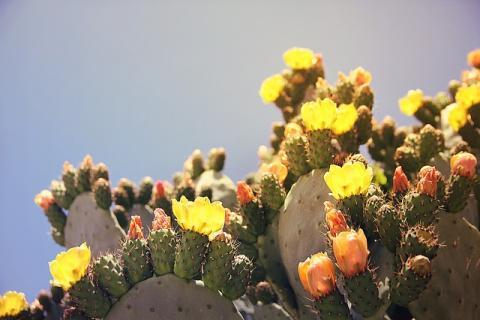
The Ancient Aztecs used the Prickly Pear Cactus (Opuntia spp.) as food and medicine. I know it doesn’t look like something you’d want to grab – or even eat – but it’s packed full of powerful properties.
It’s hard to believe that someone took a look at this very prickly cactus with spiky spines on it and thought it might be something good to eat. (Hey, someone had to discover the good stuff!) So, the rumors you may have heard about the health properties of this plant are true, and adding this cactus to your diet is in fact a good idea. Food and medicine used by the Ancient Aztecs still thrive to this very day, and there are still very many people who truly know how great this plant is.
The little flower-bearing fruits and the flat cactus paddle are edible, useful, beneficial, healthy, and pretty tasty, too. The taste of the fruit has been described as a chewy watermelon. The prickly pear is a staple food source in the mountains of Mexico, Latin America, and some regions of the United States in the semi-arid climate and desert habitat.
Superfood Qualities
The fruits and paddles of the prickly pear cactus both contain high levels of nutritional vitamins and minerals. Some of these include:
- Vitamin C
- B Vitamins
- Calcium
- Potassium
- Fiber
- Copper
- Flavonoids
- Polyphenols
- Betalains
- Magnesium
The nopales (the paddles) are used for treating diabetes, because the fiber produced by the cactus is low-glycemic and high-fiber (which is exactly the combination you need to lower the levels of blood sugar in the body). The paddles also increase the vitamin C plasma levels and reduce cholesterol and triglycerides.
The Prickly Pear Cactus plant produces sterols, which contain high levels of antioxidant properties. Antioxidants play a big role in reducing inflammation, as well as reducing the plaque build-up on our blood vessels’ walls. The flavonoids limit and minimize the free radicals, which in turn helps increase proper liver functions, and boosts overall immunity. Further, the levels of hemicellulose and mucilage in the prickly pear cactus soothe the digestive tract, and ease irritation of Irritable Bowel Syndrome, constipation, and ulcers.
If you don’t live in an area where the prickly pear cactus grows that’s no problem. Many natural food stores, health-food stores, and online stores have prickly pear products available. You can even plant your own, provided you maintain the proper climate. If you can’t find the fresh fruits or paddles, you may be able to purchase prickly pear juice, jams, jellies, and candies.
Prickly pear cactus is really tasty and truly is a super-food packed full of medicinal qualities. A big part of good health is preventative medicines and foods, and the prickly pear cactus can be a great help in your diet.
The power of prickly pear is incredible all the way around. It’s even been said that it is the perfect cure to an alcohol hangover. Don’t let the little prickly spines keep you away from this powerful super-food. Once you get the hang of properly harvesting the fruits and paddles, and learn the fastest ways to remove the spines and get to the good stuff, believe me -- it really is worth it. The cactus can be added to all sorts of meals, drinks, smoothies, and more!








